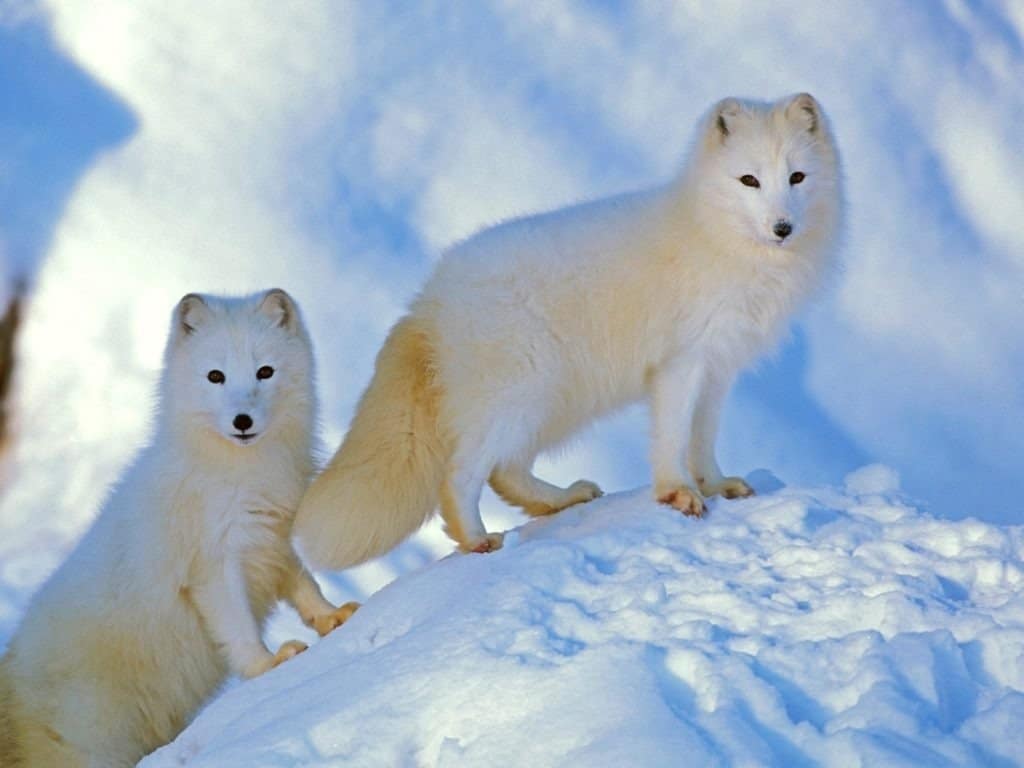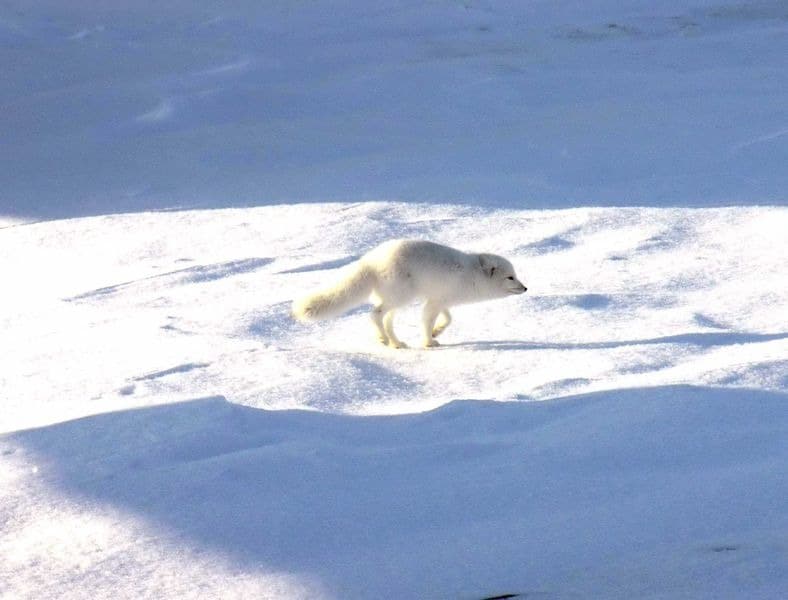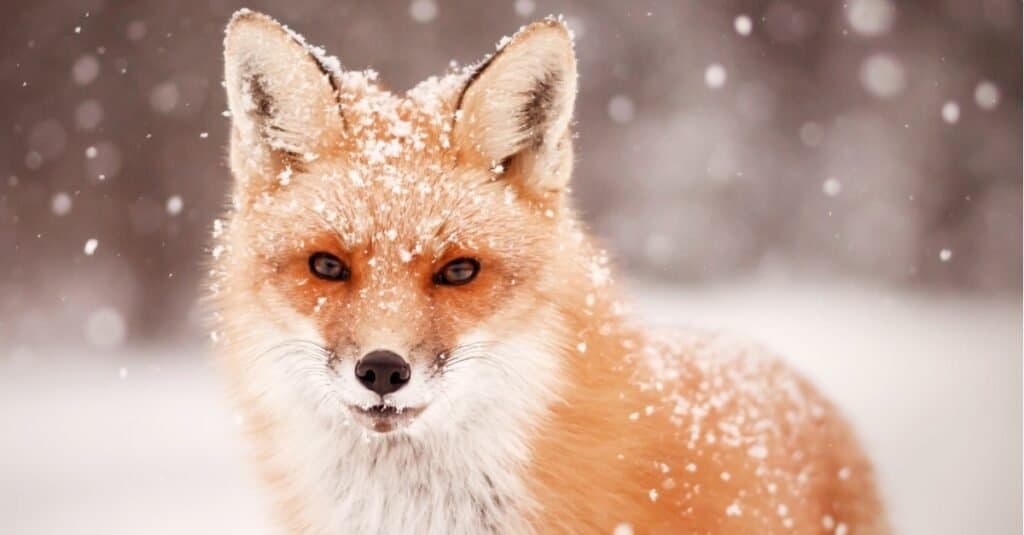Foxes can be found all over the world and on every continent except Antarctica. They can survive the harshest environments, including unforgiving desert heat and brutal arctic cold. In temperate regions with seasonal temperature changes, some mammals hibernate in the winter. But do foxes hibernate, or have they adapted other ways to cope with icy temperatures?
Do Any Species Of Fox Hibernate?
None of the twelve recognized species of fox hibernate. The Red fox and the Arctic fox are found the furthest north. Both species have adapted several adaptations for survival in very low temperatures. These adaptations include everything from their fur to their diet and one even involves that trademark fox tail!

None of the 12 recognized Fox species hibernate in winter, and the Arctic and Red Fox are perfect examples of how foxes have adapted to survive icy weather!
©rokopix/Shutterstock.com
And let’s not forget the famous cunning and intelligence that have inspired myths and legends about foxes in cultures around the world! But how does the crafty fox get around freezing temperatures that drive much larger mammals to hibernate?
Foxes Don’t Hibernate, They Adapted Instead!
Unsurprisingly, foxes use a combination of physical adaptations and advanced senses to thrive in icy temperatures. Physical adaptations include a multilayered coat of fur formed of long, coarse hair that covers a softer and thicker layer beneath. This multilayered coat provides foxes with protection from the cold and ventilation in the heat.
Additionally, the fox uses their long tail of thick fur for warmth as well. By wrapping it around themselves like a blanket, the fox has an added layer of warmth when resting or sleeping. Combined with the protection of its underground burrow, this insulating coat of fur is the foxes’ number one survival tool in icy temperatures!
How Do Foxes Find Food In The Winter?
Mammals that hibernate do so as an adaptation in seasonal environments where food becomes scarce in the winter. As omnivores, foxes change their diet to meet their nutritional needs instead of hibernating. In warmer seasons, the fox tends to eat more vegetation, like fruits and nuts. In cold weather when vegetation is harder to find, foxes hunt for more live prey.

Foxes have highly developed senses and physical features that allow them to hunt in many conditions to find food!
©Ansgar Walk / CC BY-SA 2.5, via Wikimedia Commons – License
Foxes Adapted To Hunt Animals That Hibernate!
The fox is uniquely suited to hunting in the cold and use their keen hearing and eyesight to find prey in harsh conditions. They are able to locate small animals that hibernate beneath the ground by sound alone. This advanced hearing enables a fox to not only find prey but even predict where the animal will move!
Once they detect prey, foxes use their strong front paws and thick claws to dig through hard-packed dirt. Foxes can dig up to three feet deep and use their long and pointed muzzle to grab their prey and drag it to the surface. Foxes also walk on the balls of their feet, which helps them to move almost silently.
The fox is also a highly skilled forager and scavenger. All species of fox are highly adaptable to multiple environments, allowing them to find food or shelter almost anywhere! Foxes often have many burrows throughout their territory and will store larger prey within them to eat later. These burrows are created by other animals and foxes claim them by taking them over. A fox may appropriate an abandoned burrow or claim the burrows of their underground prey.
Foxes That Conquer Cold Weather
When it comes to survival in extremely low temperatures, two species of fox stand out as the cold weather champions. The Arctic Fox and the Red Fox are highly adaptable to low temperatures and are the species of fox most likely to be found in the upper Northern Hemisphere.
Arctic Foxes Are Built For Snow!

The Arctic Fox may have brown fur in the summer, but once winter comes they grow the pure white fur this species is known for to combat the cold and seamlessly blend into the snow and ice!
©Mr. Per Harald Olsen – User Perhols on no.wikipedia / CC BY-SA 2.5, via Wikimedia Commons – License
The Arctic fox is an expert at thriving in ice and snow. This species of fox even shares the name of its habitat, which is one of the coldest places on earth! The Arctic fox species have developed specific adaptations to their environment’s low temperatures and winter weather conditions.
The Warmest Fur In The World!
This species’’ most distinct adaptation is their extremely thick multilayered coat. This fur is the warmest fur found on any mammal in the world! The fur is formed of many layers of both long coarse hair and densely packed softer layers of insulation. The Arctic fox also has multilayered fur on its foot-long tail and its paw pads and doesn’t begin to get cold until the temperature drops to -95 degrees F, or 70 degrees C!
The color of the Arctic Foxes’ fur changes seasonally and is pure white in winter months to blend in with the snow and ice to conceal them from both prey and predators. In warmer months, the fur turns brown to blend in with rock faces and cliffs.
Arctic foxes also have compact bodies, shorter muzzles, and thicker ears to combat the cold. They are also able to control their core body and paw pad temperatures separately to aid them in running through ice and snow. They conserve their energies by developing insular fat to survive, but they don’t hibernate!
Instead, they keep the complex dens and tunnels in their territories. Instead of setting up new dens yearly, fox families may use the same dens for many generations. Like other fox species, the Arctic fox uses these dens for both shelter and food storage.
Nearly everything about the Arctic fox makes it perfectly suited to surviving cold weather without needing to hibernate. For more information about how the Arctic fox is the king of cold-weather survival for its species, check out this article on the Arctic Fox!
The Red Fox Is The King Of Survivors!

The Red Fox is an expert at surviving many extreme environmental changes, and can adapt to many weather conditions, including cold weather!
©iStock.com/The_Near_North
While the Red fox didn’t specifically adapt to cold temperatures, they are true survivalists. The Red fox can seemingly adapt to anything, winter weather included! In fact, much of what we know about how the fox species thrive in unfamiliar or changing habitats we learned from the Red fox!
The Red fox may not have the thickest coat in the world, but they have a highly adaptable one. In the winter, their fur grows thicker to keep them warm and then sheds in the spring and summer to supply ventilation in warm weather. The red fox is also highly skilled at scavenging and can find food in the harshest conditions, including urban territory. The Red fox is intelligent and cunning, able to apply that intelligence and its physical agility to steal food from other animals and from humans alike!
To find out more about the Red foxes’ ability to thrive in almost any environment, take a look at this article all about the Red Fox species!
Foxes all have amazing ways that they cope with the challenges of their environments. But the Red fox and Arctic fox both have impressive adaptations specifically for surviving the cold. These amazing animals have no need to hibernate through the winter, that’s for sure!
The photo featured at the top of this post is © Andrew Astbury/Shutterstock.com
Thank you for reading! Have some feedback for us? Contact the AZ Animals editorial team.






